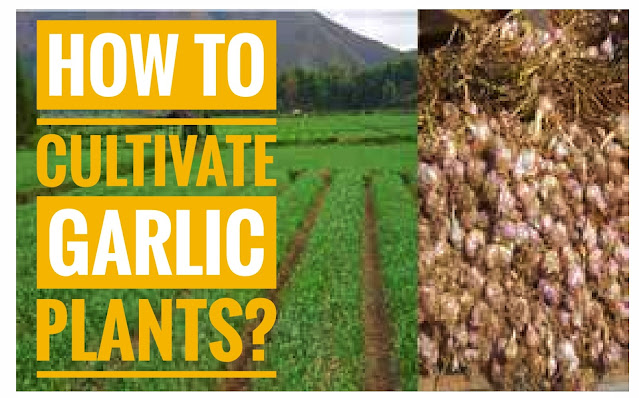Garlic
Garlic growing requirements
Garlic plants can grow in a variety of soil types. However, the preferred soil is a sandy loam textured type with a loose soil structure, with a pH of 5.5-7.
Cultivation
1. Land Preparation
Land clearing is cleaning up the remnants of previous plants that are in or above the soil surface by plowing as deep as 20-30 cm. Hijacking is done 2-3 times with an average intensity of one week.
The beds are made with a width of 60-150 cm and a height of 20-50 cm, the length of the beds is adjusted to the land. The trench between the beds for irrigation purposes is 30-40 cm wide.
The depth of the trench is greatly influenced by seasonal conditions. In the rainy season a deeper trench is required.
2. Planting
The cultivars that can be used are White Lumbu, Yellow Lumbu and Green Lumbu. Use seed tubers of uniform size and planted with a depth of 2-3 cm.
Spacing is adjusted to the size of the cloves used. If the seed clove weighs more than 1.5 grams, the spacing is 20 cm x 20 cm, but if it is smaller than 1.5 grams, the spacing is 15 cm x 15 cm or 15 cm x 10 cm.
To get good seed tubers and consumption tubers, a low planting density is used, but to get maximum production per unit area, a larger population (high density) is used. The need for seeds per hectare is 1600 kg (if the seed clove weighs 3 grams) or 670 kg (if the seed clove weighs 1 gram).
3. Fertilization
The organic fertilizer used is chicken manure at a dose of 10-20 tons/ha or goat manure at a dose of 30 tons/ha. The recommended dose of chemical fertilizers per hectare is 200 kg N, 180 kg P2O5, 60 kg K2O and 142 kg S.
Nitrogen fertilizer was applied 3 times during the growth of garlic, namely at planting time, during shoot formation (15-30 days after planting) and during tuber formation (30-45 days after planting). Phosphorus and potassium fertilizers are given as basic fertilizers together with manure at planting time.
Liquid chemical fertilizers (micro elements) can be applied to improve tuber quality and yield. For example, Cytozyme liquid supplementary fertilizer with a concentration of 0.25% was sprayed on the leaves at the age of 20 and 60 days after planting, Massmikro foliar fertilizer with a concentration of 200 ppm was applied 3 times, namely 3, 6 and 9 days after planting and Hipron fertilizer was applied 2 times. times with a concentration of 2 ml/l.
4. Mulching
Mulch in the form of rice straw or the remains of dead plants. Mulching is done in the dry season.
If done in the rainy season, it can cause soil moisture to be too high so that it is not beneficial for plant life. The use of mulch from plastic materials is not recommended because it can increase the temperature of the soil around the roots and can inhibit plant growth and development.
5. Watering
Irrigation is done by flooding the trenches between the beds. The frequency of watering depends on the age of the plant.
At the beginning of its growth, the frequency of giving water every 2-3 days as needed. During the formation of shoots until the formation of tubers, watering is done once every 7-15 days in the same way.
At the time of maximum tuber formation or 10 days before harvest, irrigation was not carried out. Improvement of drainage in the rainy season can be done by giving rice straw or compost which is placed about 10 cm below the soil surface of the bed with a thickness of 10 cm.
6. Maintenance
Weeding followed by improvement of beds with an interval of 20-30 days or adjusted to the state of the weed growth rate in the field. Weeding is not done after the garlic plant enters the generative phase, because it can interfere with the formation and enlargement of the bulbs.
7. Control of Plant Pest Organisms (OPT)
Around nineteen pests are known to attack garlic plants, including Thrips tabaci which can cause 80% damage, Spodoptera exigua, Fusarium sp., Alternaria porii and Onion Yellow Dwarf Virus (OYDV). Control is carried out with the IPM system, namely by using healthy seeds, natural enemies, controlling technical culture, using traps, sanitation, and using pesticides based on control thresholds.
Control with pesticides must be carried out properly, both in choosing the type, dose, spray volume, application method, interval and time of application.
8. Harvest and Postharvest
At the time of harvesting, all fertilizing, irrigation and spraying of pesticides were stopped. Garlic harvest depends on the variety, which is between 90-120 days after planting.
The characteristics of ready-to-harvest plants are changes in the color of the leaves from green to yellow with a withering rate of 35-60%. Harvesting is done by pulling the plant by hand when the weather is sunny.
The tuber production reaches 5.6 to 12 tons/ha. The harvested tubers are tied as much as 20-30 clumps per bunch and dried in the sun for 15 days until the stems are dry.
Drying tubers can be done by:
- Dried in the sun. The bulbs are covered with leaves to prevent the garlic bulbs from being exposed to direct sunlight.
- Dried in a layered rack by hanging, in the garden or at home.
- Fumigation, namely by placing garlic on the para-para in the kitchen. The heat and smoke come from the water that is deliberately cooked. Para-para can also be used as a storage area.
Storage in a warehouse fumigated with 55% Phostoxin tablets can extend the life of garlic bulbs up to 8 months.

